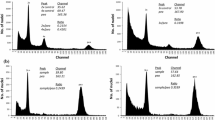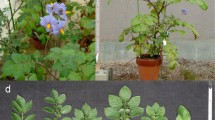Summary
In this article the term ‘pollinators’ refers to diploid genotypes of Solanum tuberosum Group Phureja which are used to pollinate autotetraploid potatoes for the induction of autonomous growth of unfertilized egg cells. Plants obtained from such egg cells contain chromosomes of the female only and are called dihaploids. The successful selection of ideal pollinators from Group Phureja is described. A pollinator is considered to be ideal, if it has good male fertility, homozygosity for the dominant seed marker embryo-spot and the ability to induce in autotetraploid cultivars a high number of dihaploids both per berry and per 100 seeds. Embryo-spot is a deep purple or reddish coloration at the base of the cotyledons of the embryo, visible on both sides of the flat seeds. It is one manifestation of a set of complementary genes with pleiotropic action, causing a concentration of anthocyanins at the base of all plant organs that are homologous to leaves. The complementary genes are: a basic gene P for anthocyanin production (this is the seedling marker ‘coloured hypocotyl’) and allele B d of locus B. Thirty-three homozygous B d B d PP plants and 41 B d bPP plants were identified and a number from both classes tested as pollinator onto varieties.
Among the homozygous group a number of ‘ideal pollinators’ could be detected. Unexpectedly a few polyploids grew from spotless seeds when using homozygous pollinators on varieties; 1.4% showed purple hypocotyl and 2.6% were matroclinous. The latter group of polyploids probably may have arisen from ‘unreduced’ egg cells of the cultivars used.
In the progenies from crosses between recessive cultivars (bbbbpppp) and heterozygous pollinators (B d bPP) the ratio of spotted: spotless hybrid seeds appeared to deviate greatly from 1:1. This is ascribed to ‘unreduced’ gametes, which originate during meiosis, presumably through lack of formation of the ‘reductional’ (= first division) cell wall. On this assumption a map distance of 30 and 24 cross-over units is estimated for locus B on the basis of the proportion of nulliplex tetraploid hybrids in two different crosses.
High- and low-seed-set pollinators were found at a ratio of 8:21 suggesting monogenic dominance of low seed-set. Seeds per berry and haploids per berry are significantly correlated using low-seed-set pollinators on cultivars, but they are not when pollinators are used that produce high numbers of seeds per berry. A hypothesis is put forward to explain this phenomenon.
Similar content being viewed by others
References
Bender, K., 1963. Ueber die Erzeugung und Entstehung dihaploider Pflanzen bei Solanum tuberosum. Z. PflZücht. 50: 141–166.
Budin, K. Z. & V. Broks, 1968. Haploids of cultivated potato. Potato and Vegetables 7: 14–15 (Russ.) (Pl. Breed. Abstr. 1969, no.895).
Budin, K. Z., 1969. Obtaining potato haploids. Genetika (USSR) 5: 42–50. (Russ.) (Pl. Breed. Abstr. 1969, no.7031).
Bukai, J., 1968. Production of dihaploid forms of Solanum tuberosum. Pl. Breed. Abstr., 1969, no. 894.
Buketova, M. M., 1970. Choice of pollinators for producing dihaploids. Potato and Vegetables 6: 12. (Pl. Breed. Abstr. 1971, no. 1291).
Buketova, M. M. & I. M. Yashina, 1971. The production of dihaploids in Solanum tuberosum and their characteristics. Genetika (USSR) 7: 39–47 (Russ.) (Pl. Breed. Abstr. 1971, no. 8159).
Chase, S. S., 1969. Monoploids and monoploid-derivatives of maize (Zea mays L.). Bot. Rev. 35: 117–167.
Coe, E. H. & K. R. Sarkar, 1964. The detection of haploids in maize. J. Hered. 55: 231–233.
Dodds, K. S., 1955. Positional pseudo-alleles in diploid potatoes. Nature, Lond. 175: 394–395.
Dodds, K. S. & D. H. Long, 1956. The inheritance of colour in diploid potatoes. II A three-factor linkage group. J. Genet. 54: 27–41.
Frandsen, N. O., 1967. Haploidproduktion aus einem Kartoffelzuchtmaterial mit intensiver Wildarteinkreuzung. Züchter 37: 120–134.
Gabert, A. C., 1963. Factors affecting the frequency of haploids in the common potato (Solanum tuberosum L.). Ph. D. Thesis, Madison, Wisconsin; Diss. Abstr. 24:475.
Hougas, R. W. & S. J. Peloquin, 1958. The potential of potato haploids in breeding and genetic research. Am. Potato J. 35: 701–707.
Hougas, R. W., S. J. Peloquin, & A. C. Gabert, 1964. Effect of seed parent and pollinator on the frequency of haploids in Solanum tuberosum. Crop Sci. 4: 593–595.
Höglund, M., 1970. Meiosis in Solanum phureja. Hereditas 66: 183–188.
Jakubiec, J., 1964. The production of haploid forms of Solanum tuberosum. Hodowla roslin aklimatyzacja i nasiennictwo, Tom 8:489–530. (Polish with English summary: 529–530).
Laptev, J. P. & R. S. Dvorjankina, 1968. Haploidy and polyploidy in the potato. Pl. Breed. Abstr., 1969, no. 2777.
Levan, A., 1941. Syncyte formation in the pollen mother cells of haploid Phleum pratense. Hereditas 27: 243–252.
Marks, G. E., 1966. The enigma of triploid potatoes. Euphytica 15: 285–290.
Mendiburu, A. O. & S. J. Peloquin, 1969. Half-tetrad analysis in potatoes by means of 4x–2x crosses. Am. Potato J. 46: 438. (Abstract).
Mendiburu, A. O. & S. J. Peloquin, 1970. Synthesis of tetraploid potatoes by interdiploid matings. Am. Potato J. 47: 357 (Abstr.).
Montezuma-de-Carvalho, J., 1967. The effect of N2O on pollen tube mitosis in styles and its potential significance for inducing haploidy in potato. Euphytica 16: 190–198.
Peloquin, S. J. & R. W. Hougas, 1959. Decapitation and genetic markers as related to haploidy in Solanum tuberosum. Eur. Potato J. 2: 176–183.
Wangenheim, K. H. von, S. J. Peloquin & R. W. Hougas, 1960. Embryological investigations on the formation of haploids in the potato (Solanum tuberosum). Z. VererbLehre 91: 391–399.
Author information
Authors and Affiliations
Rights and permissions
About this article
Cite this article
Hermsen, J.G.T., Verdenius, J. Selection from Solanum tuberosum group phureja of genotypes combining high-frequency haploid induction with homozygosity for embryo-spot. Euphytica 22, 244–259 (1973). https://doi.org/10.1007/BF00022632
Received:
Issue Date:
DOI: https://doi.org/10.1007/BF00022632




